What are ground cover roses
Ground cover roses have a special place among garden flowers. They combine decorative qualities and durability. A powerful root system and ease of care make such roses very tenacious.
Ground cover roses are low, spreading bushes, the shoots and foliage of which form a continuous carpet on the ground. Some plants extend horizontally, rising only 50 cm, while others reach 1 m in height and have flexible, cascading branches.
Ground cover roses were identified as a group only at the end of the last century, and since that time new varieties have been actively created. It is based on two species found in the wild, Rosehip wrinkled and Rosehip Vikhura. At first, groundcover rose varieties bloomed once a season and had only white, red and pink colors. Today, the plant amazes with a variety of shapes and colors, and buds are formed until frost.
Advice! Varieties with creeping shoots can be placed on a support.
There are many reasons to start growing ground cover roses:
- dense covering of greenery and flowers;
- ease of care;
- resistance against diseases and pests;
- no need for pruning;
- an adult plant suppresses nearby weeds;
- ease of reproduction.
The disadvantages of ground cover roses include low frost resistance. In the southern regions they winter well, but in the middle climate they need shelter. The shoots that grow until autumn do not have time to grow stronger and freeze out. Such branches are removed before wintering so that they do not become a source of fungal diseases.
In landscape design, ground cover roses are used in different ways:
- they cover up the shortcomings of the site;
- planted on lawns;
- placed on rocky compositions;
- directed to a support;
- used for decorating flower beds and borders;
- placed in containers and flowerpots.
Creeping roses (photo and description): the best varieties
It is difficult to list all varieties of roses: there are a great many of them. Gardeners often prefer to make their choice based on the color of the buds.
Creeping rose - pink buds
These include the Mirato variety. Bushes with rounded flowers of dark pink color, completely covered with buds immediately after the start of flowering. In the center of the bud you can see golden-colored stamens.
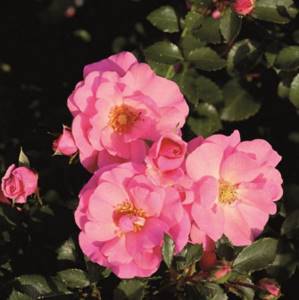
Creeping roses Mirato variety
Kniprs belongs to the same family. These are low, creeping, small-flowered ground cover roses with bright pink buds that contrast against the green foliage.
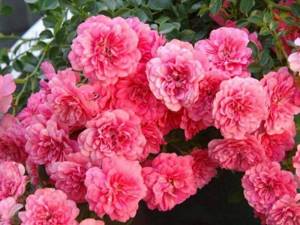
Variety Knirps
These are varieties of low-growing, creeping, non-double ground cover roses with a long flowering period: from late spring to late autumn.
Creeping rose - red, white and yellow buds
The representative of the group is the Kent rose: small, slightly velvety buds that exude a light aroma.
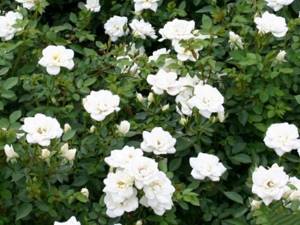
The Red Leonardо rose will enchant you with its red flowers. The medium-sized buds are distinguished by an abundance of double petals.

Red Leonardo
Creeping rose for central Russia
When choosing rose varieties for planting in central Russia, gardeners recommend being guided by the requirements of their resistance to climate conditions and aesthetics. The Fairy variety corresponds to this: its buds are striking in beauty, and at the same time this shrub is distinguished by the best resistance to weather conditions, pests and diseases. It is also worth noting a feature of the variety: the late onset of flowering (in July) continues until the onset of cold weather.

Fairy variety
Among roses with red buds, Gartnerfreude, a relatively recently created variety, should be noted. Small terry buds with a raspberry-red tint, although they do not have a strong aroma, are resistant to precipitation. Their petals do not fall off even in heavy rain.

Gartenfreude
Yellow roses, recently bred by breeders, can be represented by the Nadia Meillandecor variety. It adapts well to the soil and to the characteristics of the terrain and climate. The buds smell pleasant, are distinguished by their splendor and a delicate shade of yellow.
Roses with orange buds are not so common. An example is Apricot Clementine. The transfusion of colors from orange to soft pink will not leave anyone indifferent. The variety is characterized by resistance to diseases and precipitation: the petals stay well in the bud and do not fall off.
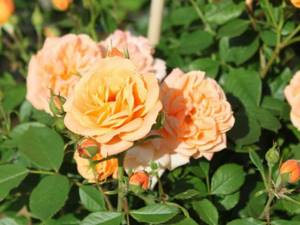
Apricot Clementine
Separately, it is worth mentioning roses with abundant flowering. In this regard, the Excelsa variety deserves attention - fast-growing bushes with raspberry-red buds. The variety withstands frosts well.
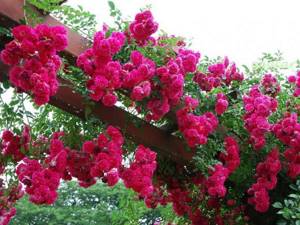
Rose Excelsa
Another variety, New Down, is not frost-resistant, but takes root well in shaded areas with depleted soil. Pink-pearl inflorescences will not leave anyone indifferent.
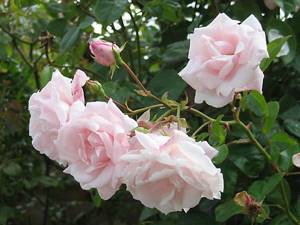
Rose New Dawn
Features of planting ground cover roses
Planting and caring for ground cover roses is easy, this is one of the reasons for their popularity. By placing a strong seedling in a suitable place, you can achieve good growth and abundant flowering for many years. Ground cover roses are not as capricious as ordinary roses.
Site selection
The plant loves light, so place it in open sunny places. It should be borne in mind that the burning midday rays can leave a burn on the petals. Planting in the shade leads to root diseases and poor development of the bush.
Advice! Ground cover roses are best placed on the southeast side of the site.
Planting is carried out at a height of about 50 cm, so the plants will be protected from melt water and frost. Ground cover roses do not do well in soils that are too wet and acidic.
Soil preparation
Before planting, it is worth clearing the ground well of weeds, because later, due to the low-lying shoots, this will be difficult to do. To prevent the appearance of unnecessary plants, the soil is mulched with sawdust, wood chips or bark in a layer of at least 4 cm. You can use black film.

The best soil for ground cover roses will be loamy, which allows moisture and oxygen to pass well to the roots. Optimal acidity is within 5.5-6.5 pH.
Landing dates
When exactly to plant ground cover roses depends on the region - in warm climates this is done in the fall, and in cold areas in the spring. This ensures maximum survival rate for young plants. If you plant a ground cover rose in the spring, it will have time to take root well and produce strong shoots by winter.
Preparation of seedlings
If it is not possible to immediately identify the seedling in a permanent place, then dig it in or place it in a dark, cool place, covering it with wet burlap. With exposed roots, the plant is soaked in a bucket of water for 3 hours. It is advisable to add a growth stimulant there. The roots should be exposed to the open air as little as possible.
Advice! If there was an order by mail, and the seedling arrived a little dry, then it can be revived by completely immersing it in a solution of epin or humate.
All dry and weak branches are removed before planting. The same applies to blackened roots. To properly trim the shoots, select a bud at a height of about 15 cm, directed outward and cut at an angle.
When planting in autumn, the branches are only slightly shortened. And if the procedure is carried out in the spring, then more radical pruning is required. In strong bushes, 2-3 buds are left on the shoots, in weakened bushes, 1-2.
Planting scheme
In the prepared area, holes are made 60 cm deep and about 50 cm wide. If there are a large number of bushes, they are placed in a trench of the same depth. The depth of the hole should be at least 10 cm greater than the length of the roots of the ground cover rose. When planting, the soil is watered in layers to prevent the formation of voids. At the end of the procedure, the top layer of soil is compacted, the seedling is watered abundantly and hilled up. When the shoots stretch 5 cm, you need to remove excess soil from the trunk and mulch. Planting density depends on the variety and can be 1-3 plants per 1 square meter. m.
Characteristics and classification
Depending on the variety, the plant can form from 80 to 150 buds on 1 bush. With the correct selection of varieties in accordance with the climate and nature of the soil, the shrub can bloom from May until frost.
The classification of ground cover roses depends on the growth and characteristics of the plant shoots. This division is rather arbitrary, but is widely used in practice:
- Shrubs that are more prone to growing in width, with shoots stretching upward. An example is the rose variety Frau Dagmar Hastrup.
- Plants with arched drooping stems more than a meter long. A striking example is the rose variety Fiona.
- Large creeping shoots like the Max Graf variety, etc.
- Shrubs of small height (up to 50 cm) with creeping horizontal shoots (border roses).
- Shrubs that grow slowly and are characterized by tough shoots. For example, Red Blanket.
Caring for ground cover roses
Caring for ground cover roses is not difficult; even a beginner in floriculture can handle it. It is necessary to carry out all its stages correctly.
Mulching
The rose is mulched immediately after planting. Use sawdust, peat or humus. This measure will help with the following:
- maintaining soil moisture;
- fertilizer;
- preventing weed growth.
It is important to do this right away, otherwise creeping shoots will interfere with mulching the rose later.
Watering
Ground cover roses require moderate watering. Both excess and lack of moisture are equally harmful. You should focus on the condition of the soil; if a layer of 3-4 cm has dried out, then watering is necessary. It is usually carried out in the morning, because the sun is not very active at this time and there is no risk of getting the leaves burned. In autumn, watering is reduced to bring the plant into a dormant state.
Loosening and weeding
The soil needs to be loosened and weeded; this can only be done until the rose bushes have grown. Then mulching helps.
Fertilizer
Ground cover roses, like any plants, require periodic feeding. During the growing season, three times are usually enough:
- early in the spring, waiting two weeks after the leaves appear, using complex fertilizers;
- after a month the roses are fed again;
- In the fall, potassium fertilizers are applied so that the shoots have time to ripen before winter.
During the flowering period, roses cannot be fertilized.
Pruning ground cover roses
Ground cover roses do not require special annual pruning. Experienced gardeners and floriculture experts recommend not to carry out this procedure at all. Pruning ground cover roses in the spring is to remove old and diseased shoots. If the bushes are planted at a sufficient distance, they will not interfere with each other and will grow and develop correctly.
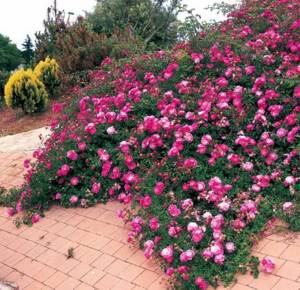
Protection from diseases and pests
Ground cover roses are susceptible to the following diseases:
- Powdery mildew is caused by a fungus that thrives in moist environments. Affects young parts of the plant. It is characterized by the appearance of a powdery white coating on the leaves and flowers, which dry out and fall off. The diseased parts of the plant are removed and burned, then the rose is treated with preparations containing copper or an ash solution.
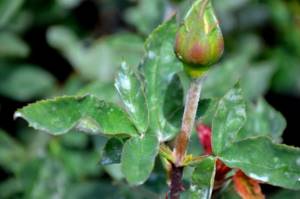
- Black spot is a fungus that occurs in summer when there is high humidity. Potassium deficiency also contributes to its development. On the upper side of the leaf you can see dark brown spots outlined with a yellow edging. Bordeaux mixture, foundationol or nettle decoction will help against black spotting.

- Rust is also caused by a fungus that is active in the spring. Yellowish tubercles appear on young shoots and leaves. The branches bend and die, the leaves turn yellow and fall off. In hot weather and low humidity, the fungus is not as active. Products containing copper will help, and you need to spray all summer, paying attention to the back of the leaf.

- Gray rot is a fungus that affects the tips of young shoots. They are covered with a gray coating, covered with a kind of down. The buds rot and fall off. Small dark spots can be seen on the petals. The disease develops in wet weather and when plantings are dense. Affected parts of the plant must be removed immediately. On rainy days, it is recommended to feed roses with fertilizers containing manganese.
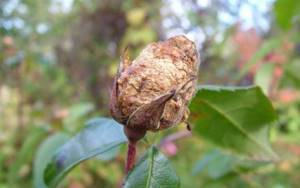
Harmful insects are also found on ground cover roses:
- Spider mites are small arachnids with a yellow or brown colored body. A web is woven on the underside of the leaf. The insect loves dry and hot weather. As a result of their activity, the leaves turn yellow and fall off. The affected parts of the roses are burned, and the bushes are treated with contact and systemic insecticides 3 times at weekly intervals.
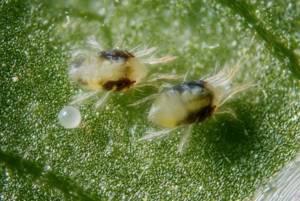
- Green rose aphid - appears in the spring and reproduces very quickly, forming giant colonies. The insect sucks the sap from the plant, weakening it and leading to death. Aphids are destroyed with insecticides, and folk remedies include a soap solution, a decoction of pepper or garlic.

- The roseate leaf roller is a butterfly whose caterpillar damages leaves by curling them, as well as shoots and buds. Insects are usually collected by hand, and rose bushes are treated with bacterial preparations. Decoctions of onion, garlic or tobacco help well against leaf rollers.

- The rose scale insect is a small insect with a white shield on its body. It can be found on the shoots and leaves of roses. It sucks out the juice, and at the site of its activity it secretes a sticky secretion, which is a favorable environment for the proliferation of sooty fungus. As a result, the plant slows down, the leaves turn yellow and fall off. Insects are removed using a damp cloth. The bush is treated with special systemic agents. Soap solutions of garlic or kerosene will also be effective.
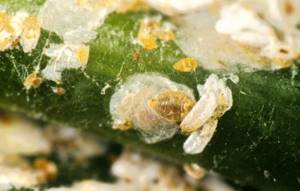
- The mole cricket is a fairly large insect that lives in the ground. Damages plant roots. Deep plowing of the soil and periodic loosening help against it. Watering with chicken droppings and planting marigolds nearby is effective.
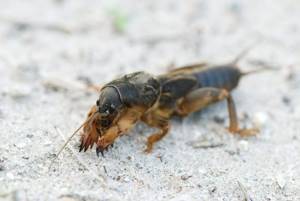
- Slobbery pennies - the larvae are found inside lumps of foam that the insect builds on the plant, weakening it. The pest sucks the juice from ground cover roses. Insects are removed manually or using a jet from a hose. Treating with an insecticide will also help.
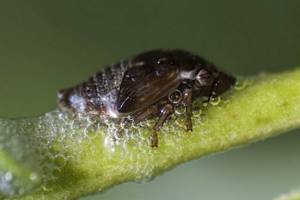
Reproduction, planting and care
Reproduction occurs through layering. The procedure is carried out in early spring. Planting groundcover beauties requires preparing not just one hole, but the entire area into which the rose will grow over time. They dig it up and get rid of weeds. The treated area is covered with tree bark or shavings, a layer of at least 3 cm. This is the only way to resist weeds at the initial stage. When the bush grows, they will no longer be able to interfere with it.
Caring for ground cover species is practically no different from others. Watering is carried out taking into account the size of the bush; sometimes it is necessary to use up to 14 liters of water at a time. This must be done in the first half of the day, directly under the bush. Moisture preferably warm temperature. Watering becomes more frequent for young seedlings and during periods of dry heat. Feeding is carried out 2-3 times during the growing season. In anticipation of a harsh winter, the bushes are covered with spruce branches. But many varieties do not even need this. The plant does not like excessive pruning. It is enough to be sanitary and maintain the natural size of the bush.
Propagation of ground cover roses
Ground cover roses are easy to propagate. There are several ways:
- layering;
- cuttings;
- seeds;
- budding.
The first two methods are the most common. Plants grown from seeds do not inherit the parental traits. This method is used by breeders. Budding is a complex method, accessible mainly to specialists or experienced flower growers.
By layering
Varieties of ground cover roses that spread along the ground can be propagated by layering without any intervention - the shoot, pressed to the ground, takes root at the knee. Such branches are sprinkled with soil, pressed tightly and watered well.
To propagate drooping varieties by layering, you need to put in a little more effort. At the end of summer, an incision of about 8 cm is made on the mature shoot and pressed to the ground. The plant must be provided with regular watering. At the end of the next season, the young plant is ready to be planted in a permanent place.
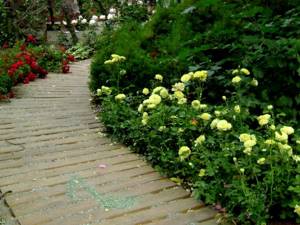
Cuttings
Propagation by cuttings of ground cover roses is also a fairly simple method. At the beginning of September, material is harvested - ripened shoots, approximately the thickness of a pencil. They must have at least 3 internodes. The cut is made under the lower bud. You should not take the apical branches for these purposes.
Advice! It is better to separate the shoot with a small piece of the skeletal branch on which it is located.
The thorns of the cuttings are broken off and the lower leaves are cut off. Then the shoots are soaked for 2 hours in a growth stimulator. They are planted in a slightly shaded area in grooves 15 cm deep, covered ⅓ with sand. The distance between the cuttings should be 15-20 cm. The bud located under the lower leaf should almost touch the soil. The groove is filled, compacted and the cuttings are watered. It is better to install signs with the names of the varieties. If buds appear during the growth process, they must be removed. The young plant will be ready to be planted in its permanent location next fall.
Rules for watering and fertilizing
Caring for ground cover representatives of the Rosaceae family is no different from caring for other types of roses. The main attention here needs to be paid to timely watering and fertilizing.
As a rule, bushes are watered in the morning, when the sun's rays do not touch the leaves. When the sun is hot, it is extremely undesirable to water the plants: moisture that gets on the foliage will cause burns. Foliar feeding and spraying carried out in the open sun can lead to the same result.
The queen of the garden is as negative about overwatering as she is about underwatering. Therefore, before watering, it is necessary to check the condition of the soil. If the soil layer has not yet dried to a depth of 3-4 cm, watering should be postponed. For the entire season, it is enough for ground cover roses to fertilize 3 times. The first is carried out in early spring, 2 weeks after the buds open. Fertilizers such as Tsitovit, Agricola, etc. are suitable. The second feeding is carried out after 30 days, and the third - in the fall. When feeding in autumn, only potash fertilizers are used.
Most ground cover varieties, especially low-growing and low-growing ones, do not need additional shelter for the winter, but during a winter with too little snow or severe winters, the likelihood of the bushes freezing is quite high. To reduce the risk of plant death, they can be covered with spruce branches. It is also recommended to build a simple frame from rods and cover it with lutrasil. The air layer will protect the bushes from frost. With proper care, the queen of the garden will delight you with lush flowering for many years.











